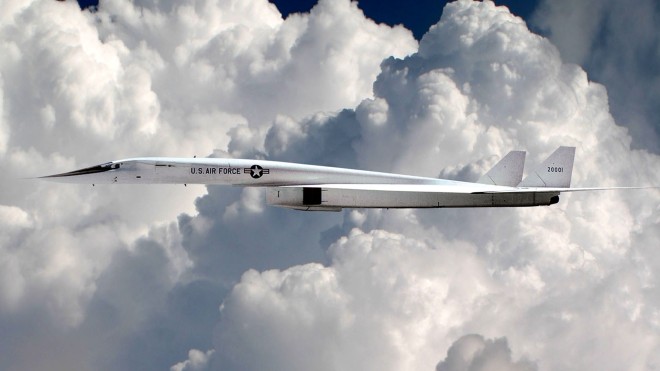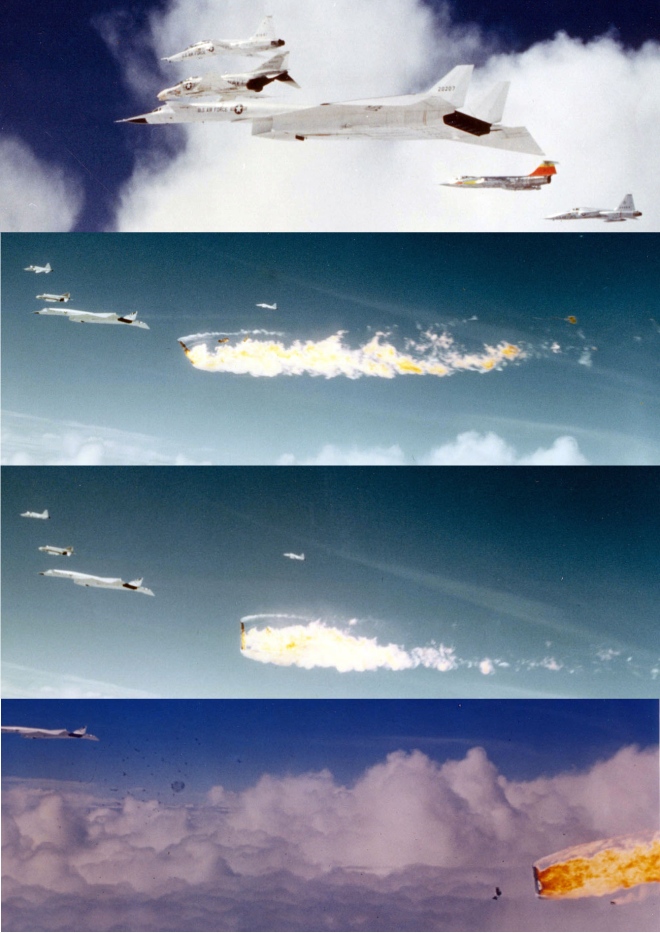This week’s plane of the week is the North American XB-70 Valkyrie.

The North American XB-70 Valkyrie is the prototype of the never-built B-70 nuclear-armed, deep-penetration strategic bomber for the U.S. Air Force’s Strategic Air Command. North American Aviation designed the Valkyrie bomber as a large, six-engined aircraft capable of reaching Mach 3+ while flying at 70,000 feet. At these speeds, it was expected that the B-70 would be almost immune to interceptor aircraft, the only effective weapon against bomber aircraft at the time. The bomber would spend only a few minutes over a particular radar station, flying out of its range before the controllers could vector their fighters into a suitable location for an interception. Its high speed also made the aircraft difficult to see on the radar displays, and its high altitude flight could not be matched by any Soviet fighter.

The introduction of the first Soviet surface-to-air missiles in the late 1950s put the near-invulnerability of the XB-70 in doubt. In response, the US Air Force began flying its missions at low level, where the missile radar’s line of sight was limited by local terrain. In this role, known as penetration, the XB-70 offered little more performance over the B-52 it was meant to replace. It was, however, far more expensive and had shorter range. A number of alternate missions were proposed, but these were of limited scope. As the strategic role passed from bombers to intercontinental ballistic missiles during the late 1950s, manned bombers were increasingly unuseful. The USAF eventually gave up fighting for its production, and the B-70 program was canceled in 1961. Development was then turned over to a research program to study the effects of long-duration high-speed flight. As such, two prototype aircraft were built, and designated XB-70A; these aircraft were used for supersonic test-flights during 1964–69. In 1966, one prototype crashed after colliding in mid-air with a smaller jet aircraft; the remaining Valkyrie bomber is in the National Museum of the United States Air Force near Dayton, Ohio. The crashed Valkyrie was not at fault, by the way.

North American engineers pored through every aerodynamic study they could find, looking for anything that could be applied to a large, triplesonic bomber. They came across a forgotten NASA research paper about “compression lift.” This paper described how a conical shape underneath the center of a wing would push the air to the side, increasing pressure under the wing section (thereby increasing lift!) with far less drag than simply increasing the size of the wing itself. To illustrate the concept, imagine a cone (like an ice cream cone). Then cut it in half lengthwise, so now you have a half cone that has a flat surface from tip to tail. Now imagine that half cone travelling through the air, flat side up, with the “belly” of the cone on the bottom. As it travels through the air, the “belly” will push the shape upwards. I don’t get it, either. In flight, the XB-70 could lower the outer wing sections either 25 degrees for flying from 300 knots to Mach 1.4, or a severe 65 degrees for speeds from Mach 1.4 to Mach 3+. Measuring just a bit over 20 feet at the trailing edge, these wingtips represent the largest movable aerodynamic device ever used.

Lowering the wingtips had three distinct effects on the XB-70:
-Total vertical area was increased, allowing shorter vertical stabilizers than would otherwise be needed.
-The reduction in rearward wing area countered the delta wing’s inherent rearward shift of the center of lift as speed increased, keeping drag-inducing trim corrections to a minimum.
-Compression lift was 30 percent more effective because the pressure under the wing was better managed.
-Along with the wingtips, the six J93 engines, bomb bay, and landing gear were all contained in a conical shape designed to enhance shockwave management.

Overall, the XB-70 has the best lift-to-drag ratio of any manned airplane ever built, being bettered only on the unmanned D-21 drone, an airframe designed to be air-launched, fly at one speed and altitude, and then self-destruct.

The XB-70 had too many problems throughout its very short operational life too be used in combat or be mass-produced, however. Many flights had had bad hydraulic problems or worse. On its twelfth flight, a piece of the air intake broke off and destroyed engines 3, 4, and 6 and severely damaged the rest. None of the engines were repairable and all had to be replaced.

Later, on its thirty-seventh flight, the landing gear failed to extend fully and it had to land on a dry lakebed so it could coast to a stop. The weight of the machine forced the landing gear into the correct positions.

The last straw was when one plane was flying in a photo shoot with an F-104 Starfighter and several other aircraft. The F-104 drifted into the XB-70, which destroyed the smaller plane and severely damaged the Valkyrie. One vertical stabilizer was knocked off, leading to severe and technically complex steering issues that I am not going to even attempt to explain. It proved impossible to fly and one pilot ejected, but the other could not escape.

This came the end of one of the most complex aircraft ever built. It’s kind of a shame, really, but the research paved the way for several high-speed planes that came after it.
I guess it must have been too far outside the box

Next week: the best trainer ever built. Guaranteed.
Very interestin airplane. It has sort of a paper airplane look to it
LikeLike
Interesting…my iPad doesn’t pick up all the letters anymore. Grrr.
LikeLike